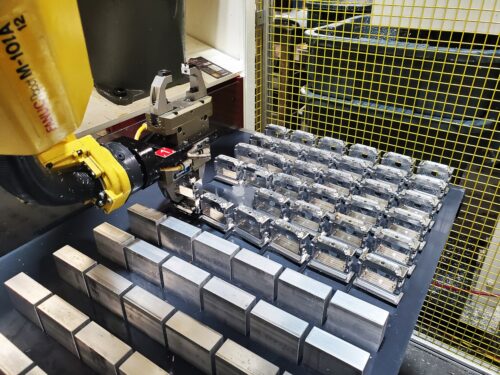 When Wagner Machine Company decided to pursue automated milling, our primary goal was to create an efficient and flexible manufacturing process. The initial emphasis was to streamline production for the types of parts and quantities our existing customers were asking for.
When Wagner Machine Company decided to pursue automated milling, our primary goal was to create an efficient and flexible manufacturing process. The initial emphasis was to streamline production for the types of parts and quantities our existing customers were asking for.
While that was a great baseline goal, we’ve continued to learn along the way. As customer requirements have evolved, we’ve adapted to handle higher volumes and tighter tolerances in our automated projects.
But leveraging automation efficiently in CNC machining requires a deep understanding of the strengths and weaknesses of various automation options and how those relate to different part requirements. So, let’s break down our milling automation into three different categories and examine the suitability of each for different types of machining projects.
Three Automation Options that Drive CNC Milling Efficiency
There are many forms of automation in manufacturing, but among the most widely used for CNC machining are robotic blank loaders, robotic pallet loaders, and integrated pallet pools. At Wagner Machine Company, we rely on all three of these processes to drive efficient production. But knowing when and how to use each option is essential for maximizing CNC milling efficiency.
Robotic Blank Loaders
Advantages:
Robotic blank loaders are ideal for production volumes ranging from 100 to over 10,000 parts. They are great for parts of almost any cycle time, and compared to other options, they are the most efficient for short cycle time parts. Suitable for small to medium parts, robotic blank loaders can be set up relatively quickly and provide the lowest operator load and unload times. Loading a whole tray only takes minutes and can run more than 24 hours unattended. The robot can also be used for cleaning operations on uploaded parts while the machine is running.
Disadvantages:
There are a few downsides to robotic blank loaders, including a higher possibility of misloads and a positioning repeatability of around .015”, which is why we only use them for first operations.
Optimal Use Cases:
With their ability to reduce custom workholding costs and minimal operator load time, robotic blank loaders can increase efficiency when manufacturing first operations on small to medium parts. We offer this service for 3-axis and 5-axis milling, so part complexity is not a limiting factor.
Robotic Pallet Loaders
Advantages:
Robotic pallet loaders allow for custom fixturing, enabling precise part location tighter than .0005”. This makes robotic pallet loaders an effective form of automation for either first or second operations on small to medium-sized parts in runs of 500 to 5,000 pieces.
Disadvantages:
Accuracy does come at a price—custom fixturing requires longer initial setup and loading times, and the fixtures themselves also add to costs. There is added inspection complexity because parts must be tracked and inspected per fixture. For these reasons, robotic pallet loaders are only efficient for parts with medium to long cycle times.
Optimal Use Cases:
Robotic pallet loaders are often used to automate parts with a complex second operation with features that have to be precisely located to previous operations. We offer this for 3-axis and 5-axis milling.
Integrated Pallet Pools
Advantages:
Integrated pallet pools are the most versatile form of automation we use in our shop. This process is suitable for parts of all sizes with cycle times greater than five minutes, and for production volumes of 10 to 10,000 pieces. Standardized, quick-change, workholding reduces tooling and setup costs even for short run production, making integrated pallet pools the ideal solution for part families.
Disadvantages:
The biggest drawback to integrated pallet pooling is the cost. It’s more expensive to implement than other forms of automation, so it may not be cost effective for some parts that don’t require the highest precision and repeatability. However, for the most critical parts, this option provides consistency that results in lower per-part prices.
Optimal Use Cases:
Pallet pool automation is ideal for complex parts with tight tolerances, and repeat jobs, where it can drastically reduce setup and changeover time compared to other options. We offer this for 5-axis parts with tolerances as tight as .0001” or 2 microns. It is by far the best option when automating parts made from tough materials, parts with critical surface finishes and tolerances, or parts that require micro-machined features.
Achieving Efficient Volume Production with Wagner Machine
For a precision machine shop like ours, maximizing efficiency without compromising accuracy is an essential and constant pursuit. This requires knowing when to leverage automation for CNC milling efficiency and when human-driven processes can actually deliver lower costs and improved results.
At Wagner Machine, we excel at finding the best methods to serve our customers. Whether you’re seeking a precision machine shop to produce complex prototypes or require a manufacturing partner for high-volume CNC machining of your most critical parts, we can provide the cost-effective precision machining services you need—and all you have to do is contact us today to get started.
